|
|

Lake Biwa is near the center of Honshu island between Nagoya and Kyoto.
|
|
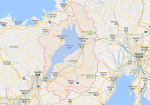
Lake Biwa (blue) in Shiga Prefecture highlighted in pink.
|
|
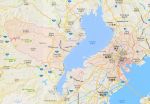
This is how Lake Biwa compares to Tokyo in area.
|
|

Southern Basin is shallow compared to the Northern Basin.
|
|
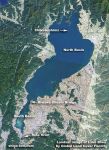
Lake Biwa has the North Basin and South Basin with the Biwako Ohashi Bridge as the border. Seta River is the only outflowing river.
|
|
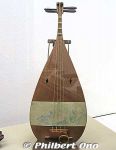
Biwa means "lute."
|
|
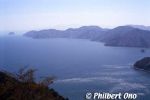
Northern Lake Biwa as seen from Mt. Shizugatake.
|
|
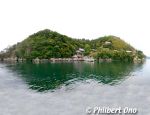
With shrines and temples, Chikubushima is a sacred island in northern Lake Biwa.
|
|
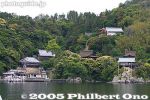
Chikubushima is home to Hogonji Temple first built in 724 as ordered by the Emperor to worship the Goddess Benzaiten. It belongs to the Shingon Buddhist Sect (Buzan School) and it is the 30th temple in the 33-Temple Pilgrimage of Saigoku. 宝厳寺
|
|

Chikubushima
|
|

Kaizu-Osaki is famous for cherry blossoms along the lake shore. One of Japan's 100 Famous Cherry Blossom Spots.
|
|

Kaizu-Osaki cherry blossom cruise. Megumi docked at Kaizu-Osaki Port, Takashima, Shiga.
|
|
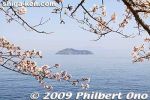
Kaizu-Osaki and Chikubushima.
|
|

Chikubushima and Mt. Ibuki as seen from Imazu.
|
|

Biwako Shuko no Uta song monument at Imazu Port. In June 1917, a song called Biwako Shuko no Uta (Lake Biwa Rowing Song) was composed by college student Taro Oguchi during a boat rowing trip around Lake Biwa.
|
|
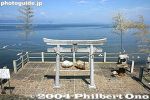
About 100 meters offshore are two large rocks in the lake. They appear above the surface only when there is a water shortage. This little shrine with two rocks are for praying for rain. 二ツ石
|
|
|
|
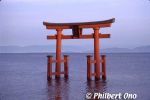
Shirahige Shrine torii, Takashima. One of Lake Biwa's best-known landmarks. It faces the shrine on land. Rent a bicycle or go by taxi from Omi-Takashima Station (Kosei Line).
|
|

Shirahige Shrine torii as seen from the cruise boat.
|
|
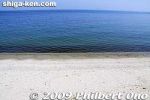
Shirahige-no-Hama Beach in Takashima. I know they did some filming here for the NHK Taiga Drama "Go" where she rides on horseback. 白ひげの浜
|
|
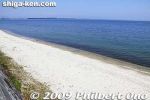
Shirahige-no-Hama Beach and Lake Biwa in Takashima, Shiga Prefecture.
|
|
|

Sugaura in northern Lake Biwa.
|
|

Cycling up northern Lake Biwa.
|
|
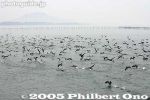
Kawau cormorants. Shiga has thousands of these birds, and most of them live on Chikubushima whose trees are being destroyed by the droppings and branches broken off to make bird nests.
|
|
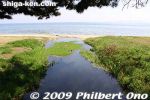
A small stream empties into Lake Biwa through Haginohama Beach. Numerous streams and rivers like this one feed water to the lake.
|
|
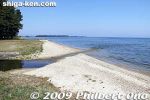
A small stream empties through Haginohama Beach on the western shore.
|
|
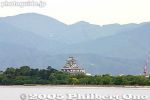
Nagahama Castle as seen from Lake Biwa.
|
|

Arrow-shaped "eri" fish trap. It leads fish swimming along the fence into a small area where they can be caught.
|
|

Okino-shiraishi Rocks, a favorite resting place for birds which turned the rocks white from bird droppings. Four rocks stand 80 meters deep in the lake. Out of the water, the tallest stands 14 meters high. 沖の白石
|
|

View of Takeshima, an island with many shapes. Near Hikone.
|
|

Mt. Ibuki in winter as seen from Hikone.
|
|

Maibara beach.
|
|

Omi-Maiko white sand beach.
|
|

Omi-Maiko is Shiga's most popular swimming beach.
|
|

Ukimido floating temple in Katata, one of Shiga's most famous and picturesque buildings. One of the eight Omi Hakkei Views made famous by ukiyoe prints by Hiroshige.
|
|

Ukiyoe woodblock print by Hiroshige showing "Descending Geese at Katata" with Ukimido in the background. 近江八景「堅田の落雁」
|
|
|

Neck of Lake Biwa with Biwako Ohashi Bridge connecting Moriyama and Katata.
|
|

Biwako Ohashi Bridge is a toll road (200 yen for ordinary passenger cars), but free for bicycles and pedestrians who can go on the sidewalk. There are actually two parallel bridges, making it a four-lane bridge. The additional bridge was built in 1994.
|
|

South Basin
|
|
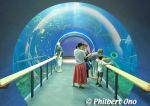
Lake Biwa Museum in Kusatsu.
|
|

Lake Biwa Giant Catfish is the lake's largest endemic species (max. 1.2 meter long), dubbed the King of Lake Biwa.
|
|
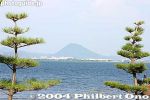
Mt. Mikami across Lake Biwa from Karasaki.
|
|

Hiyoshi Taisha Shrine's boat dock is used during the Sanno Festival when they carry the portable mikoshi shrines on a boat.
|
|

View of Lake Biwa and Otsu. Omi Ohashi Bridge in the background. The towering building is Otsu Prince Hotel.
|
|
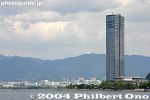
Top of Otsu Prince Hotel has nice views.
|
|
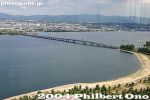
Omi Ohashi Bridge in southern Lake Biwa leading to Seta River.
|
|

Biwako Bunkakan museum closed in March 2008. The museum was known for Buddhist art, including National Treasures.
|
|
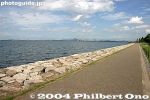
Otsu waterfront
|
|
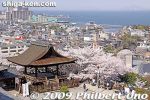
Miidera in Otsu.
|
|

Michigan paddlewheel boat leaving Otsu Port, Shiga Prefecture, Japan.
|
|

Uminoko Floating School operates overnight cruises for 5th graders to learn about Lake Biwa.
|
|
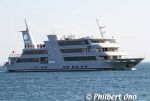
Bianca is Lake Biwa's largest tourist boat.
|
|
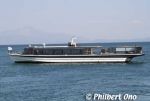
Most of Lake Biwa's boats are named after Otsu's sister cities. This is Lansing.
|
|
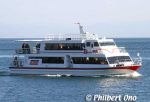
Rio Grande
|
|
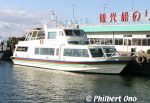
Hikone Port
|
|

Setagawa River boat cruise modeled after the Ichiban-Maru paddlewheel steamboat which cruised on Lake Biwa in the 19th century. In operation during warmer months from Ishiyama-dera port and stopping at Nango Aqua Biwa and Seta-no-karahashi ports.
|
|

Seta Karahashi Bridge in Otsu.
|
|
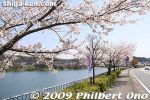
Cherry blossoms along Seta River in Otsu, Lake Biwa's only outflowing river.
|
|

Seta River in Otsu, Lake Biwa's only outflowing river.
|
|

Lake Biwa Canal near Miidera Temple supplies lake water to Kyoto.
|
|
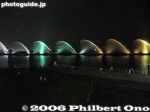
Nightly water fountain show at Otsu Port.
|
|
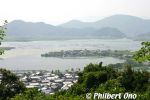
Lake Nishinoko, an attached lake in Omi-Hachiman.
|
|
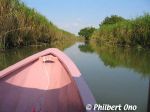
Lake Nishinoko reed beds.
|
|
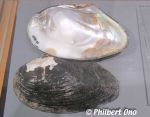
Lake Biwa pearl mussel.
|
|
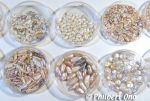
Lake Biwa pearls.
|
|
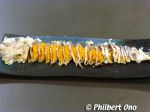
Funazushi fermented carp fish.
|
|

Lake Biwa and cherry blossoms as seen from Nagahama Castle.
|
|
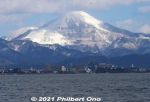
Snowy Mt. Ibuki as seen from Lake Biwa. Shiga Prefecture's highest mountain.
|
|

Snowy mountains all around. Mt. Ibuki can be seen on the right. It was a smooth ride.
|
|
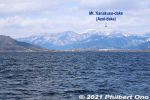
Mt. Kanakuso-dake (金糞岳 or Azai-dake) overlooks Takatsuki in Nagahama. Kanakuso-dake is indeed Shiga's second highest mountain (1,317 m). Part of Yamamoto-yama (dark green) can be seen on the left in the foreground.
|
|

Mt. Kanakuso-dake (金糞岳 or Azai-dake) behind Takatsuki in Nagahama. The peak to the left is Shirakura-dake (白倉岳). The orange/white smokestack is from the Nippon Electric Glass factory (日本電気硝子) in Takatsuki.
|
|
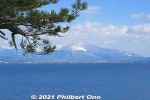
Mt. Ibuki as seen from Chikubushima.
|
|
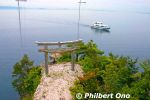
Hogonji's Shinto shrine has this iconic torii facing the lake. You can buy small clay dishes to throw at the torii. If your dish goes through the torii, your wish will come through. However, most dishes never make it through the torii. They litter the ground.
|
|

Chikubushima's west side.
|
|

On the mountain top is Biwako Hakodateyama ski grounds near Imazu. びわこ箱館山
|
|

Approaching Imazu in winter.
|
|
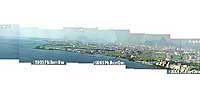
Southeastern shore of Lake BiwaAs seen from Mt. Hiei Driveway. Kusatsu and Moriyama are in view.
|
|

Ducks seek the protection of the reeds.
|
|
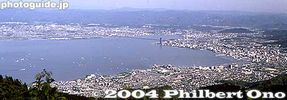
View of Lake Biwa and Otsu from Enryakuji Station.
|
|
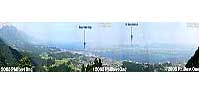
Panoramic view of Lake Biwa from Mt. Hiei.
|
|
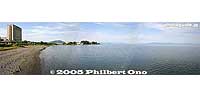
Lake Biwa shore in Imazu, with a boat landing in the distance
|
|
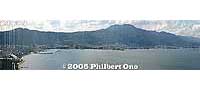
Otsu shoreline and Mt. HieiAs seen from the Otsu Prince Hotel.
|
|
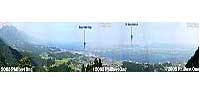
View from Mt. Hiei
|
|
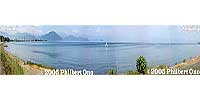
Near Imazu, Takashima
|
|

Tundra swans from Siberia at Lake Biwa.
|
|

Bean geese at Lake Biwa.
|
|

Lakeside park in northern Nagahama. This area was formerly Biwa-cho town which merged with adjacent Nagahama in Feb. 2006.
|
|

Minamihama swimming beach, Nagahama 南浜
|
|

Minamihama swimming beach in Nagahama. Pebble beach. 南浜
|
|

About Lake Biwa
|
|

Albino Lake Biwa Giant Catfish
|
|

Black bass, an invasive species in Lake Biwa which eats the babies of native fish. If you catch one of these, you must not throw it back into the lake. Dispose of it.
|
|

Largemouth bass (black bass) and bluegill are Lake Biwa's worst invasive species. They eat eggs and fry of native fish, crustaceans, and insects.
|
|

Around the lake are disposal bins for invasive fish. Do not throw invasive fish back into the lake.
|
|
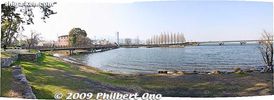
Lakeside at Zeze Castle Park.
|
|
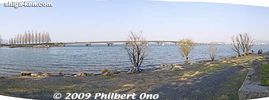
Lakeside at Zeze Castle Park with Omi Ohashi Bridge in the distance.
|
|
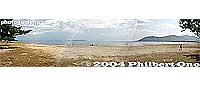
Omi-Shirahama Beach on Lake Biwa. MAP
|
|
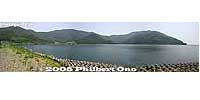
Northern Lake Biwa (Sugaura)
|
|
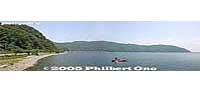
Near Sugaura in northern Lake Biwa
|
|
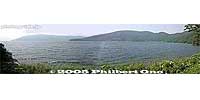
Sugaura in northern Lake Biwa
|
|
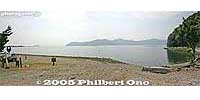
Takatsuki-cho
|
|
|
|
|